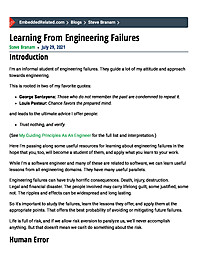
Learning From Engineering Failures
IntroductionI'm an informal student of engineering failures. They guide a lot of my attitude and approach towards engineering.This is rooted in two of my favorite quotes:George Santayana: Those who do not remember the past are condemned...

Acceptance Tests vs. TDD
The Question Our software book club at work is reading Michael Feathers' Working Effectively with Legacy Code. This is an outstanding book that's worth re-reading every few years. This week, we went over Chapter 8, "How Do...
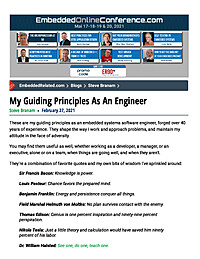
My Guiding Principles As An Engineer
These are my guiding principles as an embedded systems software engineer, forged over 40 years of experience. They shape the way I work and approach problems, and maintain my attitude in the face of adversity. You may find them useful as...
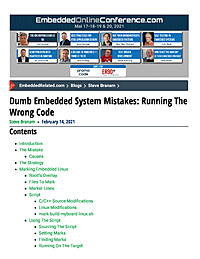
Dumb Embedded System Mistakes: Running The Wrong Code
Contents Introduction The Mistake Causes The Strategy Marking Embedded Linux Rootfs Overlay Files To Mark Marker Lines Script C/C++ Source Modifications Linux...
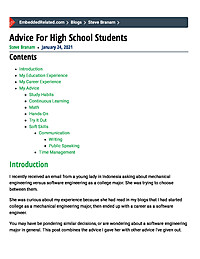
Advice For High School Students
Contents Introduction My Education Experience My Career Experience My Advice Study Habits Continuous Learning Math Hands-On Try It Out Soft Skills ...
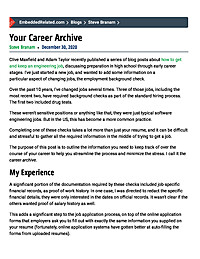
Your Career Archive
Clive Maxfield and Adam Taylor recently published a series of blog posts about how to get and keep an engineering job, discussing preparation in high school through early career stages. I've just started a new job, and wanted to add...
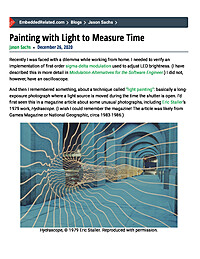
Painting with Light to Measure Time
Recently I was faced with a dilemma while working from home. I needed to verify an implementation of first-order sigma-delta modulation used to adjust LED brightness. (I have described this in more detail in Modulation Alternatives for the...

Review: Hands-On RTOS with Microcontrollers
Full disclosure: I was given a free copy of this book for evaluation.Hands-On RTOS with Microcontrollers: Building real-time embedded systems using FreeRTOS, STM32 MCUs, and SEGGER debug tools by Brian Amos is an outstanding book. It lives...
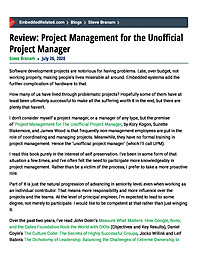
Review: Project Management for the Unofficial Project Manager
Software development projects are notorious for having problems. Late, over budget, not working properly, making people's lives miserable all around. Embedded systems add the further complication of hardware to that. How many of us...

Scorchers, Part 3: Bare-Metal Concurrency With Double-Buffering and the Revolving Fireplace
This is a short article about one technique for communicating between asynchronous processes on bare-metal embedded systems. Q: Why did the multithreaded chicken cross the road? A: to To other side. get the — Jason Whittington There...
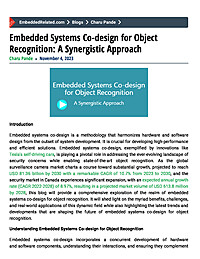
Embedded Systems Co-design for Object Recognition: A Synergistic Approach
Embedded systems co-design for object recognition is essential for real-time image analysis and environmental sensing across various sectors. This methodology harmonizes hardware and software to optimize efficiency and performance. It relies on hardware accelerators, customized neural network architectures, memory hierarchy optimization, and power management to achieve benefits like enhanced performance, lower latency, energy efficiency, real-time responsiveness, and resource optimization. While challenges exist, co-designed systems find applications in consumer electronics, smart cameras, industrial automation, healthcare, and autonomous vehicles, revolutionizing these industries. As technology advances, co-design will continue to shape the future of intelligent embedded systems, making the world safer and more efficient.
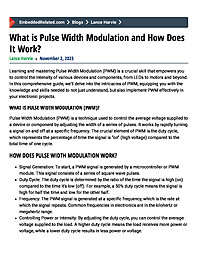
What is Pulse Width Modulation and How Does It Work?
Pulse Width Modulation (PWM) is a technique used to control the average voltage supplied to a device or component by adjusting the width of a series of pulses. It works by rapidly turning a signal on and off at a specific frequency. The crucial element of PWM is the duty cycle, which represents the percentage of time the signal is “on” (high voltage) compared to the total time of one cycle.
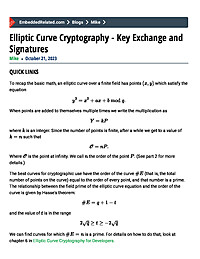
Elliptic Curve Cryptography - Key Exchange and Signatures
Elliptic curve mathematics over finite fields helps solve the problem of exchanging secret keys for encrypted messages as well as proving a specific person signed a particular document. This article goes over simple algorithms for key exchange and digital signature using elliptic curve mathematics. These methods are the essence of elliptic curve cryptography (ECC) used in applications such as SSH, TLS and HTTPS.
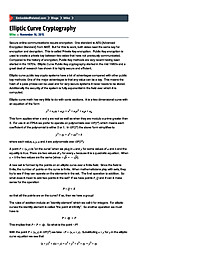
Elliptic Curve Cryptography
Secure online communications require encryption. One standard is AES (Advanced Encryption Standard) from NIST. But for this to work, both sides need the same key for encryption and decryption. This is called Private Key encryption.
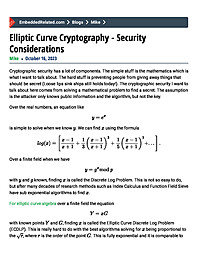
Elliptic Curve Cryptography - Security Considerations
The security of elliptic curve cryptography is determined by the elliptic curve discrete log problem. This article explains what that means. A comparison with real number logarithm and modular arithmetic gives context for why it is called a log problem.
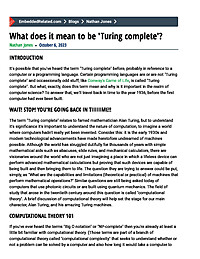
What does it mean to be 'Turing complete'?
The term "Turing complete" describes all computers and even some things we don't expect to be as powerful as a typical computer. In this article, I describe what it means and discuss the implications of Turing completeness on projects that need just a little more power, on alternative processor designs, and even security.
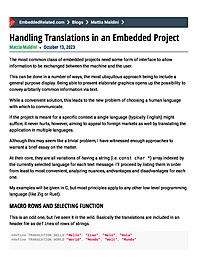
Handling Translations in an Embedded Project
A brief walkthrough on how to handle human language translations in a low level C application. Some options are listed, each with advantages and disadvantages laid out.
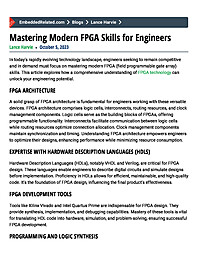
Mastering Modern FPGA Skills for Engineers
In the rapidly evolving tech industry, engineers must acquire proficiency in modern FPGA skills. These skills empower engineers to optimize designs, minimize resource usage, and efficiently address FPGA design challenges while ensuring functionality, security, and compliance.
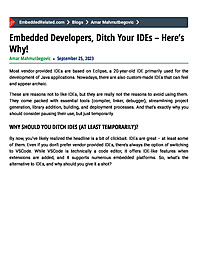
Embedded Developers, Ditch Your IDEs – Here’s Why!
Ditching your Integrated Development Environment (IDE) temporarily can be a transformative learning experience in embedded development. This post invites you to explore the underpinnings of IDEs by delving into alternative tools and processes like Makefile, CMake, Vim, GDB, and OpenOCD. Understanding these tools can demystify the background operations of IDEs, revealing the intricacies of compiling, linking, and debugging. This journey into the “under the hood” aspects of development is not just about learning new tools, but also about gaining a deeper appreciation for the convenience and efficiency that IDEs provide. By stepping out of your comfort zone and experimenting with these alternatives, you can sharpen your skills, enhance your knowledge, and possibly discover a more tailored and streamlined development experience. Whether you're a novice or a seasoned developer, this exploration promises insights and revelations that can elevate your embedded development journey.




















